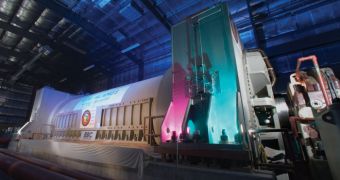Experts from the National High Magnetic Field Laboratory, located in Tallahassee, close to Florida State University, are currently undergoing operations required for the creation of the most potent magnet built to date. The Los Alamos National Laboratory in New Mexico will house the object 2 million times more powerful than the magnet of your average refrigerator, which, upon completion, is said to be able to resist forces equal to the explosion of 200 dynamite sticks.
I'm sure the first question that pops in your minds (it was the same for me as well) is either "Why?" or "What for?" Well, the director of the laboratory, Greg Boebinger, answers that this $10 million solution is the only way of testing the behavior of the recently discovered high-temperature superconductors (such as iron oxyarsenide) that improve and lower the cost of MRI devices (magnetic resonance imaging machines, particularly used in medicine in order to obtain accurate pictures of any plane of the body) or high-voltage power lines. Even more, such magnets would allow scientists to perform zero gravity tests and experiments on Earth and discover means of magnetic propulsion in order to replace the fuel burning ones.
They are still 10 Tesla away from the targeted 100 T goal. Boebinger states that "We've been running it at the hairy edge" without destroying it. The challenge they’re facing is to build a magnet that will still resist after reaching that limit, as other previous attempts that breached this barrier caused the respective magnets to collapse under their own force. This happens because of a phenomenon known as the Lorentz force, an electromagnetic force that tries to drive electrons perpendicularly on the current flow. The director of the lab says that in such a magnet, we're talking about the "equivalent to the explosive force of 200 sticks of dynamite packed into a volume of space the size of a marble."
Skipping the tons of technical data, it can be stated that the device will be comprised of 2 parts: a thick and hollow cylinder (the outsert) measuring 1.5 m both in height and in diameter, and an insert fitting the 225 mm bore of the outsert. During the 2 second power-up of the outsert (it can only withstand that much at a time), so much energy is transferred that its temperature rises from that of liquid nitrogen to almost 200°C. An hour must pass before the operation can be reiterated, because that’s how long it takes for the cooling process to be complete. Boebinger says the $8 million outsert part will hold for about 10.000 pulses while the $20.000 insert piece will only resist to around 100 pulses. He says that "Simply put, pulse magnets are applied metal fatigue. The trick is to hold off the breakdown of the bonds between the molecules due to mechanical and thermal stresses for as long as you can."
He and his team provided the magnet with 9 nested wire coils, with 2 of them (the innermost ones) registering Lorentz forces that create pressures 30 times that on the bottom of the ocean. It is there where the researchers placed nanoparticle wires composed of 82% copper and threaded through with a few hundred atoms-across silver strands. This combination is 100 times stronger than any of the 2 metals alone. After crossing that border, things become easier, according to Boebinger: "The further out you go, the lesser the forces are, so you can afford to use material that is not as strong and not nearly as expensive."

 14 DAY TRIAL //
14 DAY TRIAL //